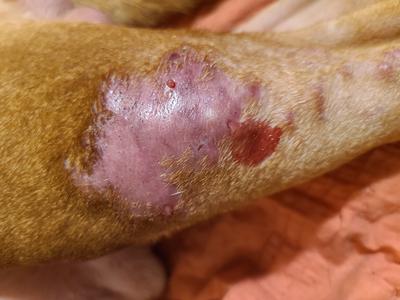Sore on Dogs Leg
by Tammy
(Wilkes-Barre, PA , United States )
Can you tell me what this is om my dogs leg. It's red swollen missing hair. It does have a light bloody watery discharge in some spots.
Suggestions from our editor on possible causes and related treatment approaches for a dog leg sore
Hi Tammy,
So sorry to hear about your dog's leg issue.
Looking at the image you've provided, the affected area on your pet's leg appears to be an open sore with some inflammation and a central area that might be ulcerated or infected.
It's important to keep in mind that skin conditions can be due to a variety of causes, and without a physical examination and diagnostic tests, it's challenging to provide a precise diagnosis.
However, based on the image, here are the most likely reasons for this condition:
Infection: The presence of discharge indicates a high likelihood of infection, potentially a pyoderma, which is common in dogs.
Recommendation: Keep the area clean and visit your veterinarian for a possible course of antibiotics and to rule out or confirm bacterial infection.
Allergies or Atopic Dermatitis: The symptoms you described could be associated with allergies, which can cause skin irritation, leading to secondary infections.
Recommendation: Your vet might recommend allergy testing, antihistamines, or steroids to control the inflammation and an Elizabethan collar to prevent further irritation.
Hot Spot: The
Recommendation: Immediate veterinary care is important as hot spots can spread quickly. Treatment usually involves clipping the area, cleaning, and applying medicated ointments or sprays.
Parasitic Infestation: Fleas or mites can cause intense itching, leading to skin damage and secondary infections.
Recommendation: Confirm that your pet is up-to-date with flea and tick prevention. Your veterinarian may prescribe anti-parasitic medications if an infestation is identified.
Fungal Infection: Such as ringworm, can cause inflammation, hair loss, and scabby, oozing skin.
Recommendation: Fungal cultures or skin scrapings by your vet can diagnose this, and antifungal medications would be prescribed.
While these are the most likely possibilities, only a physical examination can provide a definitive diagnosis. It’s essential to get your dog to a veterinarian quickly, as skin conditions can deteriorate rapidly. They may also recommend diagnostic tests such as skin scrapings, cultures, or biopsies to further identify the cause.
Keep monitoring the area for any changes, but try to prevent your dog from licking or scratching it.
I hope your dog feels better soon and please keep us up to date on the condition.
Jeff
Editor and Publisher
Dog Health Guide
Note: This advice is intended for guidance and does not replace an in-person veterinary consultation.
Join in and write your own page! It's easy to do. How? Simply click here to return to Skin.


